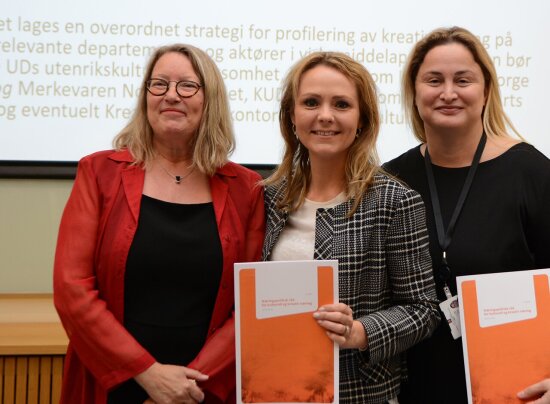The Industrial Policy Council for Cultural and Creative Industries was appointed by the Ministry of Cultural Affairs (KUD) and Ministry of Trade, Industry and Fisheries (NFD) in 2015. Their mandate was to provide recommendations on business development in the cultural and creative industries and several of the Council’s recommendations have already been adopted.
The third and final list of recommendations was submitted to the Minister of Cultural Affairs Linda Hofstad Helleland and State Secretary Dilek Ayhan from the Ministry of Trade, Industry and Fisheries by the secretary of the Council and head of the BI Centre for Creative Industries, Anne Britt Gran.

Photo: Martin B. Andersson/Kulturdepartementet
- DOGA supports recommendations
- DOGA supports the Council’s proposals and is ready to get to work. “We hope the government adopts these measures, which we believe will strengthen the cultural and creative industries, both nationally and internationally,” says CEO Trude Gomnæs Ugelstad.
Four of the ten recommendations focus specifically on the fields of design and architecture and are described in the Council’s report as follows:
New design enrolment options in interaction and service design
Digital interaction solutions and user-driven service design are increasingly important in a complicated society in both the public and private sectors. All the same, there are not enough enrolment options in these design areas and the demand for this expertise is critical. A recent study conducted by the interaction designers’ branch organisation IxDA shows that there are twice as many vacancies in Norway in interaction design as there are educated candidates with the relevant expertise. The Council suggests that the Ministry of Education and Research analyse the entire educational process in the field of design and establish new possibilities to study interaction and service design.

Photo: DOGA
Innovation team for increased public innovation in design and architecture
Public procurements should be exemplary in terms of innovation, lateral thinking and sustainable solutions. There is a significant need for innovation and restructuring in several sectors and this requires new ways of working and a multidisciplinary approach. The fields of design and architecture meet these needs, especially with regard to the design of public services and smart city and urban development. There is increasing interest in the creative industries in the public sector, but also an increasing need for greater expertise. The Council suggests establishing an ‘innovation team’ (i-team) for government and municipal activities with interministerial funding that can be established and managed in partnership between Difi (Agency for Public Management and eGovernment), DOGA and AHO (The Oslo School of Architecture and Design).

Photo: Adobe Stock
New programme for young architects
Norway has a unique sector structure within the field of architecture, with numerous small and medium-sized companies. These agencies contribute to innovative solutions, new types of collaboration and to strengthening Norway’s international competitive advantage. At the same time, however, this structure is challenged by the fierce competition faced by small and medium-sized companies when participating in large construction projects. To strengthen and update the core competence of younger architects and to further develop this unique sector structure, the Council suggests creating a permanent programme for young architects that includes resources from NFD and that can be developed and administered by DOGA.
Fund for early testing of sustainable architectural solutions
In its ‘Green competitive advantage’ efforts, the government has indicated that the building industry lags behind when it comes to working towards new sustainable solutions. The Council therefore suggests establishing a fund with resources for early testing and prototypes. The fund can be created by allocating a small percentage of all government building projects, such as one percent, to this purpose and can be administered by DOGA. This could help strengthen sustainable restructuring and innovation in the building industry with only a minor investment.

Photo: Reiulf Ramstad Arkitekter
International focus on the creative industries
Many of the other recommendations also involve the fields of design and architecture.
The Council suggests, for example, to expand and strengthen Innovation Norway’s export programme ‘Ut i verden’(Stepping Out into the World), in which architecture is this year’s focus and DOGA is a collaborative partner. Some creative industries are so closely related, such as design and architecture, that the initiative can be extended parallel to two sectors.
There is also a considerable need for the creative industries to be highlighted and profiled to a much greater extent internationally. The Council suggests establishing a primary strategy that applies to all ministries and all parties in the policy implementation system and which involves the Ministry of Foreign Affairs’ international cultural activities, NFD through Innovation Norway’s Tourism Department and Merkevaren Norge (Norway as a Brand), KUD (through Norwegian Arts Abroad, in which DOGA is also represented) and possibly the Kreativt Norge (Creative Norway) office of the Norsk Kulturråd (Arts Council Norway).
